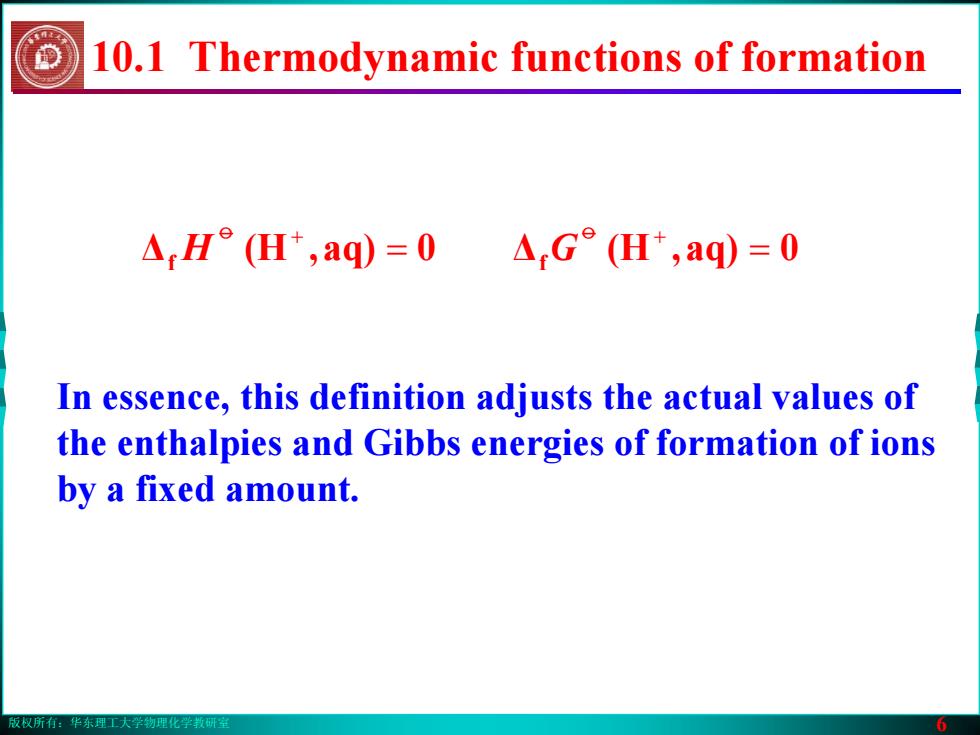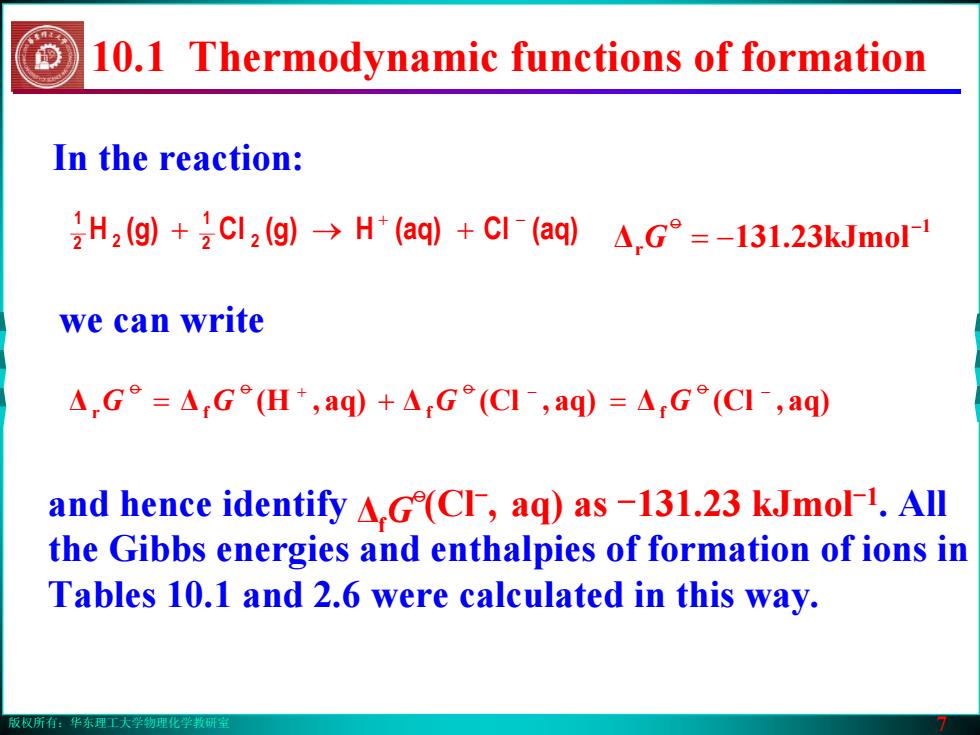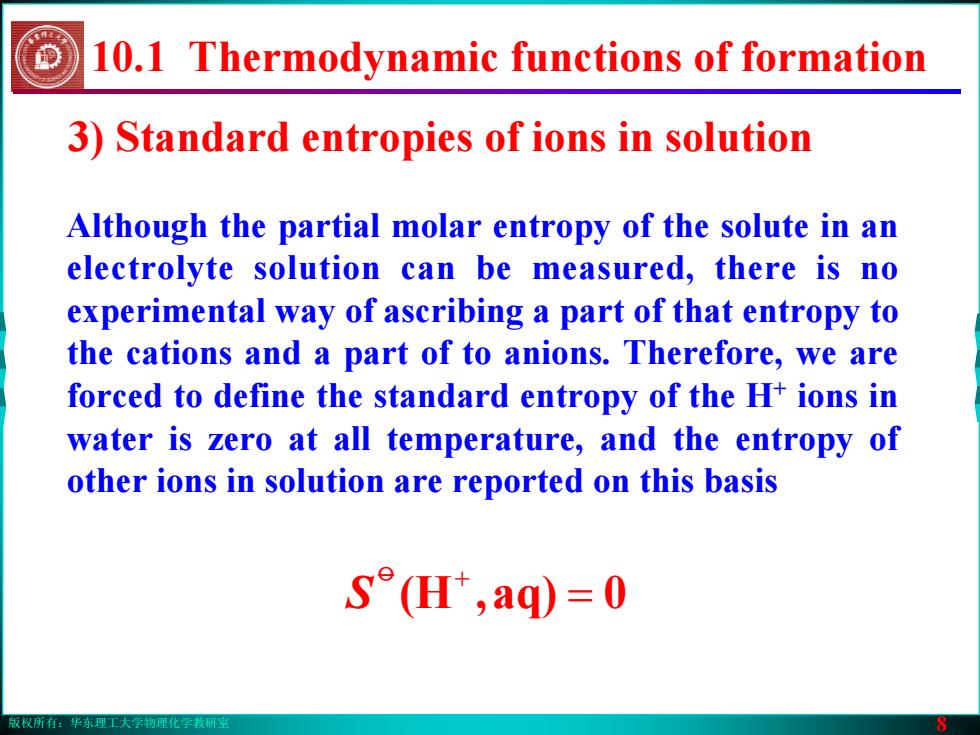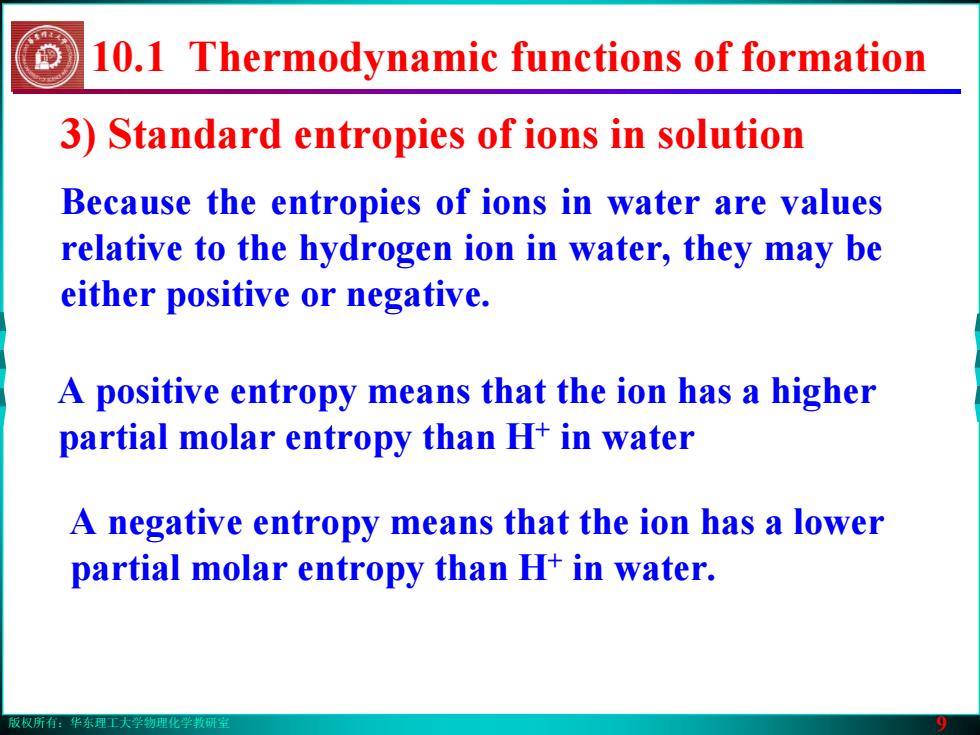
版权所有:华东理工大学物理化学教研室 6 In essence, this definition adjusts the actual values of the enthalpies and Gibbs energies of formation of ions by a fixed amount. 10.1 Thermodynamic functions of formation Δ 0aq),(H f = o + Δf = 0aq),(H G o + H
版权所有:华东理工大学物理化学教研室 6 In essence, this definition adjusts the actual values of the enthalpies and Gibbs energies of formation of ions by a fixed amount. 10.1 Thermodynamic functions of formation Δ 0aq),(H f = o + Δf = 0aq),(H G o + H

版权所有:华东理工大学物理化学教研室 7 In the reaction: 2 (aq)Cl(aq)H(g)Cl(g)H 21 2 2 1 + − + → + we can write ΔΔ aq),(H Δ aq),(Cl Δ aq),(Cl r f f f + − − = + = oo o o GG G G 1 Δr kJmol23.311 − −= o G and hence identify (Cl-, aq) as -131.23 kJmol-1. All the Gibbs energies and enthalpies of formation of ions in Tables 10.1 and 2.6 were calculated in this way. Δf o G 10.1 Thermodynamic functions of formation
版权所有:华东理工大学物理化学教研室 7 In the reaction: 2 (aq)Cl(aq)H(g)Cl(g)H 21 2 2 1 + − + → + we can write ΔΔ aq),(H Δ aq),(Cl Δ aq),(Cl r f f f + − − = + = oo o o GG G G 1 Δr kJmol23.311 − −= o G and hence identify (Cl-, aq) as -131.23 kJmol-1. All the Gibbs energies and enthalpies of formation of ions in Tables 10.1 and 2.6 were calculated in this way. Δf o G 10.1 Thermodynamic functions of formation

版权所有:华东理工大学物理化学教研室 8 Although the partial molar entropy of the solute in an electrolyte solution can be measured, there is no experimental way of ascribing a part of that entropy to the cations and a part of to anions. Therefore, we are forced to define the standard entropy of the H+ ions in water is zero at all temperature, and the entropy of other ions in solution are reported on this basis 3) Standard entropies of ions in solution = 0aq),(Ho + S 10.1 Thermodynamic functions of formation
版权所有:华东理工大学物理化学教研室 8 Although the partial molar entropy of the solute in an electrolyte solution can be measured, there is no experimental way of ascribing a part of that entropy to the cations and a part of to anions. Therefore, we are forced to define the standard entropy of the H+ ions in water is zero at all temperature, and the entropy of other ions in solution are reported on this basis 3) Standard entropies of ions in solution = 0aq),(Ho + S 10.1 Thermodynamic functions of formation

版权所有:华东理工大学物理化学教研室 9 Because the entropies of ions in water are values relative to the hydrogen ion in water, they may be either positive or negative. 3) Standard entropies of ions in solution A negative entropy means that the ion has a lower partial molar entropy than H+ in water. A positive entropy means that the ion has a higher partial molar entropy than H+ in water 10.1 Thermodynamic functions of formation
版权所有:华东理工大学物理化学教研室 9 Because the entropies of ions in water are values relative to the hydrogen ion in water, they may be either positive or negative. 3) Standard entropies of ions in solution A negative entropy means that the ion has a lower partial molar entropy than H+ in water. A positive entropy means that the ion has a higher partial molar entropy than H+ in water 10.1 Thermodynamic functions of formation

版权所有:华东理工大学物理化学教研室 10 The thermodynamic properties of ions in solution 10.1 Thermodynamic functions of formation 10.2 Ion activities Electrochemical cells 10.3 Half-reactions and electrodes 10.4 Varieties of cells 10.5 Standard potentials Applications of standard potentials 10.6 The electrochemical series 10.7 Solubility constants 10.8 The measurement of pH and pK 10.9 Thermodynamic functions from cell potential measurements 10. Equilibrium electrochemistry
版权所有:华东理工大学物理化学教研室 10 The thermodynamic properties of ions in solution 10.1 Thermodynamic functions of formation 10.2 Ion activities Electrochemical cells 10.3 Half-reactions and electrodes 10.4 Varieties of cells 10.5 Standard potentials Applications of standard potentials 10.6 The electrochemical series 10.7 Solubility constants 10.8 The measurement of pH and pK 10.9 Thermodynamic functions from cell potential measurements 10. Equilibrium electrochemistry